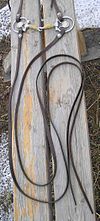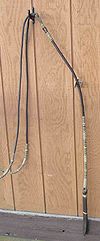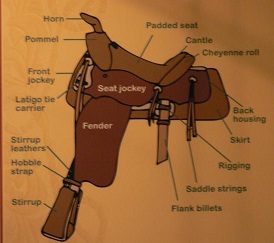|
Western equitation (sometimes called Western horsemanship, stock seat equitation, or, in some classes, reining seat equitation) competitions are judged at the walk, jog (jog is the Western term for English trot), and lope (lope is the Western term for English canter) in both directions. Riders must sit to the jog and never post. Horse Gaits Regular and Artificial (Footfalls) Footfalls/Walk, jog, lope, etc., explained..
Riders must use a Western saddle and a curb bit, and may only use one hand to hold the reins while riding. Two hands are allowed if the horse is ridden in a snaffle bit or hackamore, which are only permitted for use on "junior" horses, defined differently by various breed associations, but usually referring to horses four or five years of age and younger. Horses are not allowed to wear a noseband or cavesson, nor any type of protective boot or bandage, except during some tests that require a reining pattern.
Riders are allowed two different styles of reins: 1) split reins, which are not attached to each other, and thus the rider is allowed to place one finger between the reins to aid in making adjustments; and 2) "romal reins," which are joined together and have a romal (a type of long quirt) on the end, which the rider holds in his/her non-reining hand, with at least 16 inches of slack between the two, and the rider is not allowed to place a finger between the reins.
 
Split Rein (left) and Roman Rein (Right)
The correct position for this discipline, as in all forms of riding, is a balanced seat. This is seen when a bystander can run an imaginary straight line that passes through the rider's ear, shoulder, hip, and heel.
The Western style is seen in a long stirrup length, often longer than even that used by dressage riders, an upright posture (equitation riders are never to lean forward beyond a very slight inclination), and the distinctive one-handed hold on the reins. The reining hand should be bent at the elbow, held close to the rider's side, and centered over the horse's neck, usually within an inch of the saddle horn. Due to the presence of the saddle horn, a true straight line between rider's hand and horse's mouth is usually not possible.

Western Saddle
Western riding is a style of horseback riding which evolved from the ranching and warfare traditions brought to the Americas by the Spanish Conquistadors, and both equipment and riding style evolved to meet the working needs of the cowboy in the American West. American cowboys needed to work long hours in the saddle over rough terrain, sometimes needing to rope cattle with a lariat (or lasso). Because of the necessity to control the horse with one hand and use a lariat with the other, western horses were trained to neck rein, that is, to change direction with light pressure of a rein against the horse's neck. Horses were also trained to exercise a certain degree of independence in using their natural instincts to follow the movements of a cow, thus a riding style developed that emphasized a deep, secure seat, and training methods encouraged a horse to be responsive on very light rein contact.
Though the differences in equipment appear dramatic, fewer differences between English and Western riding exist than most people think. Both styles require riders to have a solid seat, with the hips and shoulders balanced over the feet, with hands independent of the seat so as to avoid jerking the horse in the mouth and interfering with its performance.
Western Pleasure is a western style competition at horse shows that evaluates horses on manners and suitability of the horse for a relaxed but collected gait cadence and relatively slow speed of gait, along with calm and responsive disposition. The horse is to appear to be a "pleasure" to ride. Most light horse breeds in the United States and Canada may compete in western pleasure classes, either in open competition or at shows limited to a single breed. However, horse conformation and temperament play a role in this event, and hence animals that are calm, quiet, have collected, soft gaits and the strong muscling required to sustain slow, controlled movement are the most competitive.
For More Information:
United States Equitation Federation 
 Western Riding Western Riding 
|